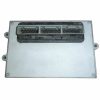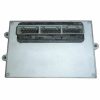Restore Peak Performance to Your 1996 Dodge Truck
Is your trusty 1996 Dodge Ram 1500, 2500, or 3500 starting to show its age with frustrating engine problems? Before you start replacing countless sensors, consider the brain of the operation: the Engine Control Module (ECM). Over time, the original electronics in these workhorse trucks can fail, leading to a host of issues that can sideline your vehicle. This replacement engine computer is the definitive solution, designed to restore your truck’s original performance and reliability without the hassle and expense of a dealership visit.
This unit arrives at your door fully programmed to your truck’s specific Vehicle Identification Number (VIN) and current mileage. This means the installation is a true ‘Plug and Play’ experience. There’s no need for specialized scanners, programming tools, or trips to a mechanic for software flashing. Simply install the module, and you’re ready to get back on the road. It’s the most straightforward and effective way to solve complex electronic issues and breathe new life into your 5.9L V8 Magnum engine.
I once had a 1996 Dodge Ram 2500 come into the shop that had its owner completely stumped. He had replaced the O2 sensors, the MAP sensor, and even the throttle position sensor trying to chase down a rough idle and stalling problem that only happened after the truck warmed up. His check engine light was on, but the codes were intermittent and pointed to different sensors each time. After checking the wiring and confirming the new sensors were good, we hooked up a scope to the ECM’s output signals. We found that the injector driver circuits inside the original computer were failing under heat. We installed one of these pre-programmed units, and the truck immediately ran like it just rolled off the assembly line. It’s a classic case of symptoms pointing everywhere, but the root cause being the central computer.
Is Your Dodge Showing Signs of a Bad ECM?
A failing engine computer can manifest in numerous ways, often mimicking other component failures. If you’re experiencing any of the following, a faulty ECM is a likely culprit:
- ✔ Check Engine Light: An illuminated Check Engine Light (CEL) with communication error codes (like P0601, P0605) or a variety of seemingly unrelated sensor codes.
- ✔ Starting Problems: The engine cranks but refuses to start, or experiences very long crank times before finally firing up.
- ✔ Poor Engine Performance: Noticeable loss of power, hesitation during acceleration, and a significant drop in fuel economy.
- ✔ Stalling and Rough Idle: Your truck may stall unexpectedly at stoplights or idle erratically, surging or dropping RPMs for no reason.
- ✔ Erratic Transmission Shifting: The ECM plays a key role in transmission function. A bad module can cause harsh shifts, delayed shifting, or the transmission getting stuck in one gear (limp mode).
- ✔ No Communication: Your OBD-II scan tool is unable to connect or communicate with the vehicle’s computer system.
Why Choose Our 1996 Dodge 2500 Engine Computer?
This isn’t just a part; it’s a complete, hassle-free solution. We handle the complex programming so you don’t have to. Engineered to meet or exceed original equipment specifications, this module ensures seamless integration with your vehicle’s systems. It directly replaces a wide range of original part numbers, making it a versatile and reliable choice for your repair.
Compatible Part Numbers: 04886735, 04886786, 04886851, 05014152AA, 56040780, 56040821, 56040892, 56040931, 56040975, 04886919
Fitment for 5.9L (360ci) V8 Gas Engines with Automatic Transmission:
- 1996 Dodge 1500 Pickup
- 1996 Dodge 2500 Pickup (Standard Duty)
- 1996 Dodge 3500 Pickup (Standard Duty)
Simplified Installation Process
You don’t need to be a master technician to install this part. The ECM is conveniently located on the right-hand (passenger side) firewall in the engine bay.
- Safety First: Always disconnect the negative terminal from your truck’s battery.
- Locate and Disconnect: Find the ECM on the passenger-side firewall. Carefully release the locking tabs on the large electrical connectors and pull them straight out.
- Remove the Old Unit: Unbolt the few screws holding the module to the firewall and remove it from the vehicle.
- Install the New Unit: Mount your new, pre-programmed computer in the same location, ensuring it is secure.
- Reconnect: Firmly plug the electrical connectors back into the new module until they click into place. Reconnect your battery terminal.
- Final Step: Start your truck and let it idle for a few minutes. The system is now ready to go.
Frequently Asked Questions
Is this 1996 Dodge 2500 Engine Computer truly ‘Plug and Play’?
Absolutely. We program the module using the VIN you provide during checkout. This ensures it has the correct software and security information for your specific truck, eliminating the need for any additional programming after installation.
Where is the ECM located on my 1996 Dodge truck?
The Engine Control Module is located in the engine compartment, mounted to the firewall on the passenger side of the vehicle. It’s a silver metal box with large electrical connectors.
Will this computer fix my check engine light?
If the check engine light is caused by an internal failure of the ECM (common codes include P0601 – Internal Control Module Memory Check Sum Error), then this part will solve the problem. However, if the light is on due to a separate faulty sensor or wiring issue, that issue will still need to be addressed.
What information do you need from me to program the module?
We require your vehicle’s 17-digit Vehicle Identification Number (VIN) and the current mileage. You can typically find the VIN on your dashboard (visible through the windshield) or on the driver’s side door jamb sticker.
How can I be sure this fits my truck?
This module is compatible with 1996 Dodge Ram 1500, 2500, and 3500 pickups equipped with the 5.9L (360) V8 gasoline engine and an automatic transmission. You can confirm compatibility by matching the part number from your old unit to one of the numbers listed in our description.


